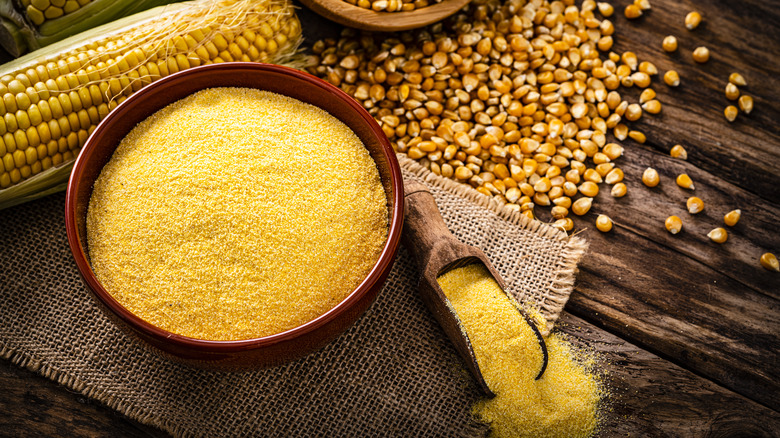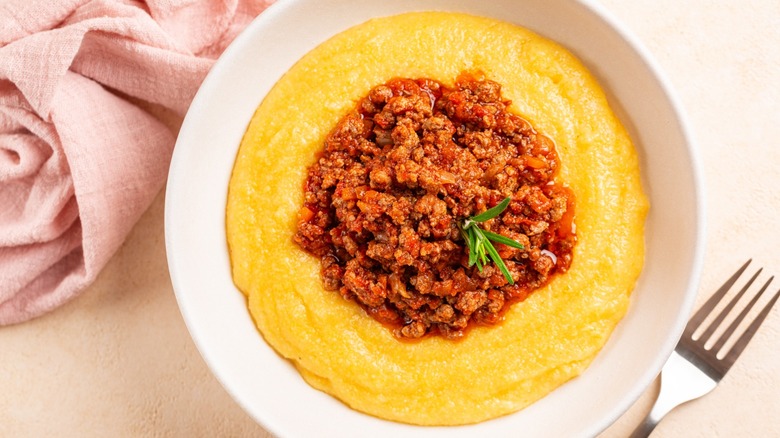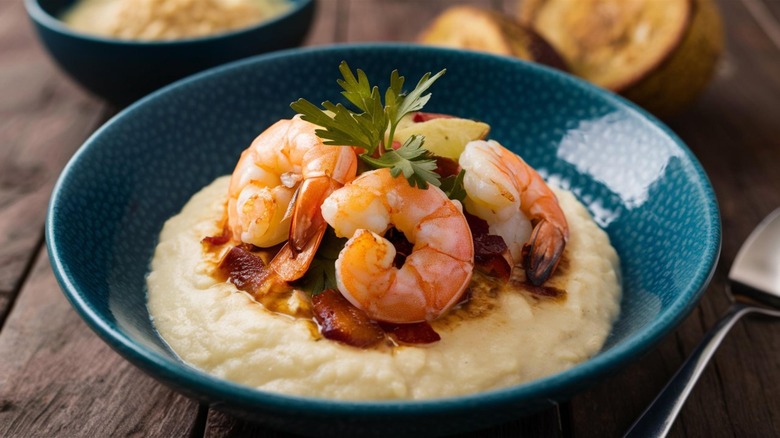The Difference Between Polenta And Cornmeal Mush
Have you ever wondered about the difference between polenta and cornmeal mush? Since they're both corn-based comfort foods that look similar, is it merely a marketing gimmick, or are these two dishes actually unique? If you've been asking yourself these questions, we've got answers. Let's dive into the delicious details.
For starters, polenta and cornmeal mush are names of dishes, not ingredients. They are both made by simmering ground cornmeal in liquid. However, cornmeal can take several forms. It can have a fine, medium, or coarse grind, and come from yellow, white, or blue corn. To simplify things, polenta is an Italian dish typically made from coarse ground yellow cornmeal. Meanwhile, cornmeal mush has American roots and is a more general term for porridge made from corn.
However, the differences between polenta and cornmeal mush don't end there. They have distinct uses, and are often prepared and served in unique ways. They also have separate origin stories and cultural significances; polenta isn't merely the Italian version of cornmeal mush. But if you're stuck with a box of one and wondering if you can use these items interchangeably, read on. We're getting down to the nitty-gritty, so you can fully understand what these dishes are all about.
What is polenta?
When we think of polenta, we think of boiled golden cornmeal. However, polenta wasn't always made of cornmeal. The term originally referred to a variety of porridges, including farro, millet, or chickpeas. It wasn't until corn was brought over from the New World that cornmeal became a staple in Northern Italian cuisine. And nowadays, when people say polenta, they're likely referring to the corn-based variety — which doesn't just come from any corn. Authentic polenta is made from eight-row flint corn, an heirloom variety that originally hails from Italy.
When you see a box labeled "polenta," you can expect that authentic Italian flavor and consistency. Although you can substitute other types of cornmeal for polenta and vice versa, you may pick up on slight differences. Polenta is also cooked longer than cornmeal mush to achieve a firmer consistency. This perfect polenta recipe requires 45 to 60 minutes of cooking time, after which it can be served straight from the pot. This results in a soft, creamy texture that absorbs the taste of whatever is added. A little bit of butter or cheese goes a long way. Alternatively, you can fry or grill polenta after it sets (that cold leftover polenta can be made into delicious crispy croutons).
Polenta is often considered a savory appetizer, side dish, or a pasta replacement. It can be topped with sautéed mushrooms, ragù, or spicy sausages. But don't be afraid to sway from convention. A bowl of polenta topped with tomato sauce and fried eggs makes an excellent breakfast. And polenta with mascarpone, walnuts, and honey is exquisite for dessert.
What is cornmeal mush?
Cornmeal mush is deeply rooted in American history. Indigenous tribes used ground corn as a staple in their cuisine for millennia before European settlers adopted this dish and, over time, it transformed into a modern-day comfort food. It's particularly popular in Eastern and Southern states, and nowadays, cornmeal mush is served in a variety of ways.
This dish is often described as easier to make than polenta. Perhaps it's because chefs frequently use a finer grain, requiring significantly less stirring. And much like its name would suggest, cornmeal mush is mushier than polenta. Grits are just one type of cornmeal mush. It's made from soft starch corn treated with lime, resulting in a super smooth porridge with a pronounced corn flavor. This Southern staple can be sweet or savory, but is almost always served hot. Use it in place of oatmeal for breakfast, or top it with bacon and eggs. For a Southern-inspired dinner or lunch, whip up this spicy shrimp and cheese grits recipe. And if you're feeling brave, try livermush, a mashup of — you guessed it — liver and cornmeal mush.
Like polenta, cornmeal mush can also be served fried. Fried cornmeal mush is primarily found in Ohio and Indiana. It's a fantastic gluten-free alternative to pancakes and waffles, and tastes incredible with maple syrup.


